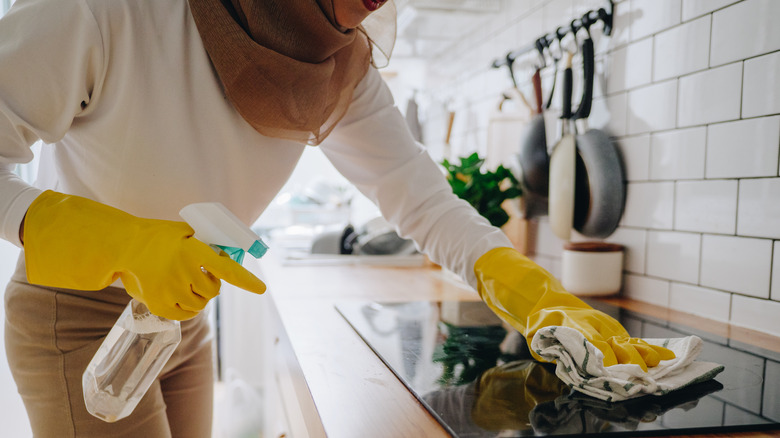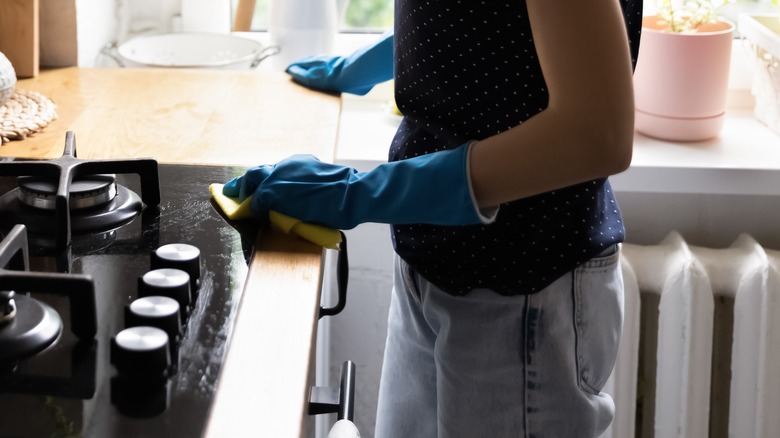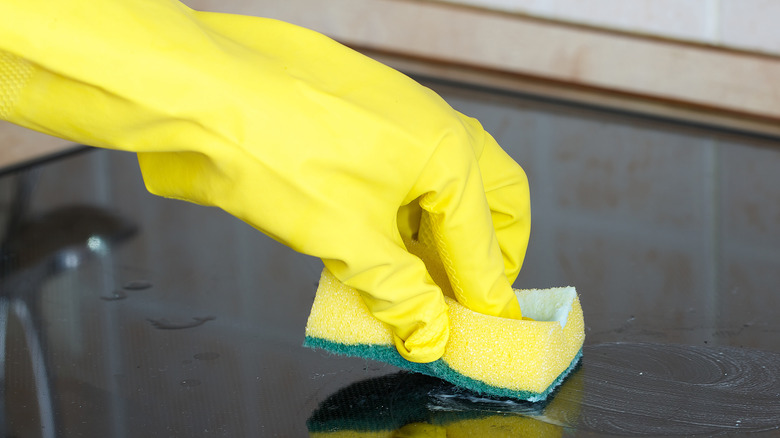Can You Clean Your Glass Stovetop With Windex?
If you've ever watched "My Big Fat Greek Wedding," you'll know Windex has a reputation for being handy for just about anything. That said, using Windex is one of the biggest mistakes you can make when cleaning your glass top stove. We're not exaggerating, here — doing so could actually see you lose your warranty.
Don't feel bad if you were under the impression that Windex was a safe bet for stovetops. After all, "My Big Fat Greek Wedding" aside, Windex's website suggests using the product to keep stovetops clean. For that reason, one could easily be led to believe that reaching for the product was completely fine. So, why the confusion? As it turns out, while Windex claims to be safe for use on glass stovetops, several well-known stovetop manufacturers have left it off their recommended products lists. KitchenAid, for instance, only recommends Affresh. GE, meanwhile, suggests Weiman and Cerama Bryte.
Here's the real stinger: GE and KitchenAid aren't just suggesting using those brands. They actually warn, in their respective warranties, that using something outside of what's been recommended could stop you from being able to get your stovetop fixed by them. It's pretty clear, then, that Windex should be approached with serious caution. That said, looking at the product's ingredients, we're not exactly surprised.
The ammonia in Windex poses a problem
According to KitchenAid, it's the ammonia in Windex that makes it risky for stovetop cleaning. More specifically, Weiman warns that the ammonia can actually stain the stovetop — especially if you use it regularly. In other words, in addition to not being approved, it might actually create more of a problem on your stovetop than you had before. Once again, this is your sign to think again before cleaning with Windex.
Granted, many people may know that Windex now offers an ammonia-free version of the product. This goes for around $4 at Walmart, so it costs less than a dollar more than the original formulation. Cost-effective and ammonia-free, that certainly could be enticing for many. And, while stovetop manufacturers warn against the traditional Windex, at the time of writing, none have spoken about the newer formulation. However, we're still going to suggest avoiding it on your stovetop.
The reality is, if you did see some kind of damage after using the ammonia-free Windex, you may still run into trouble with your warranty. It's simply not worth the risk using anything other than what's suggested by your manufacturer, so until such time as you get the green light, save the Windex for windows and other glassware.
Follow the cleaning instructions
So, if you're going to avoid Windex and its ammonia-free alternative, how should you clean your glass stovetop instead? For this, it's vital to check in with your specific manufacturer's instructions. As we said before, GE and KitchenAid suggest different products, so your first port of call should be whatever is recommended in your user's manual.
If your manual recommends Affresh cooktop cleaner, a la KitchenAid, at the time of writing, Amazon offers the lowest price at just $4.99. If, on the other hand, your manufacturer recommends Cerama Bryte, a set including the cleaner, scrubbing pads and a scraper goes for just under $13 on Amazon. As for the Weiman alternative, if that's the option you're recommended to use, you'll get the best deal at Walmart, where a bottle goes for just over $5. Or, if you'd prefer not to buy anything just yet and are open to trying a pantry staple, Affresh notes that vinegar can be pretty effective, too.
This probably goes without saying, but arguably the best way to clean your glass stovetop is to clean it after every cooking session and any spill. That way, you won't need to do as much heavy-duty cleaning. Again, though, be sure to check in with your manufacturer on how to do that. The goal is to keep that warranty in place, so their recommendations are your number one go-to.


